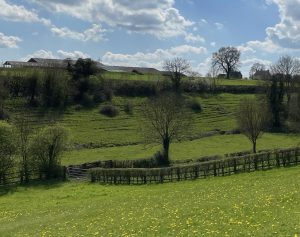Our landscape, our history
The landscape we see today tells us much about how we lived in the past. It has evolved over thousands of years of human activity, settlement and exploitation of the land.
We take a look at just some of the landscape archaeology and physical features evident in Wiltshire, primarily within the parish of Nettleton, to draw a timeline of our history.
Palaeolithic, Mesolithic and Neolithic
We’ll dispense quickly with the Palaeolithic and Mesolithic periods (c. 53,000-6,500 BCE) as human activity from this time is not perceptible in the current landscape. Suffice to say, the earliest Wiltshire residents limited their activity to river valleys. As the exploitation of grazing animals took hold, some woodland clearance occurred.
Neolithic society engaged in rituals, which they expressed in the development of monuments, such as at Stonehenge and Avebury, and the creation of causewayed enclosures and burial mounds (long barrows).
The most prominent barrow in Nettleton is the Lugbury Long Barrow (ST 8306 7855) 500m north of Lugbury Farm.
A D Passmore (1939) described a further long barrow, near the junction of the Cotswold Way with Shire Hill (ST 7808 7791). He recorded it as 135ft long by 60ft wide, 6.50ft high, on a NE-SW axis, and partly ploughed.
Pugh (1957) recorded a round barrow east of Lugbury long barrow (ST 8330 7860) which had been ploughed away in 1630.
Bronze and Iron Age
The Bronze Age saw an increase in population and monumentalised ritual behaviour. Society built large numbers of barrows in land occupied similar locations to their Neolithic predecessors.
The cropmark of a ring ditch (ST 8100 7757), probably a barrow, north of the track between Drifton Hill and Holloway Hill, West Kington, is visible on aerial photographs (see image below).
The layout of fields became formalised, using terraces and ditches. This field layout represents the earliest recognisable divisions of the land for agricultural in the county.
Roman Period
The Romano-Britons continued to developed extensive agricultural systems.
The establishment of a road network connected settlements, farmsteads and fields. These linear features still exist within the landscape and often helped to define boundaries of later holdings and fields.
The Fosse Way is still in use today. An excavation by Clifford Bateman (1998) indicates a section of the road was diverted, hence its slight dink into a section of hollow road in the Nettleton Shrub area.
Agricultural technology improved, allowing expansion onto heavier clay vales.
For more on our Roman history, see Temple of Apollo.
Saxon
Towns and villages proliferated across Wiltshire. In some instances, the Saxon origin of these settlements survives and remains legible.
Some Saxon estate or administrative boundaries may still be reflected in more modern boundaries and field systems.
Nettleton village has Saxon origins with settlement earthworks surviving. Its earliest mention is 940 (Gover, 1939).
In certain parts of Wiltshire, Saxon fields took the form of strips which continued into the medieval era where they were grouped into large open fields. The ridge and furrow created by the plough headlands is still visible today.
Ridge and Furrow

The ridge and furrow effect was a result of ploughing with non-reversible ploughs on the same strip of land each year.
During the Saxon and medieval period ploughing was done with teams of oxen, typically eight in four yokes. The Saxon peasant overcame the issue of ploughing to the end of the furrow, by turning the team to the left along the headland, while the plough continued as close to the headland as possible. Each pair of oxen were then turned around to cross the end of the strip, before starting down the opposite furrow. By the time the plough reached the beginning of the furrow, the oxen were lined up ready to pull.
Thus each furrow was twisted slightly to the left, making a slight reverse-S shape, which survives in some places as curved field boundaries. (Cotswold Journeys, 2019).
Remnants of a Saxon ridge and furrow field-system of about 2 ha. north of Priory Farm, Nettleton are visible in aerial photography.
Medieval
Medieval open fields, comprised of strips or furlongs, were created around settlements and typically arranged in a two-field or three-field system. Elements of ridge and furrow or stepped/jointed field boundaries attest to this former character. These morphological traits can survive quite well within later field systems and are very distinct in their appearance.
The medieval period also saw the exploitation and use of forests within Wiltshire for the purposes of hunting and resource gathering.
The formalisation of parish boundaries occurred during the medieval period and many of these have survived into the modern period.
The earliest mention of Burton is from 1204 (Gover, 1939). Its church is Norman, but was rebuilt in the 14th century.
West Kington dates to around 1195 (Gover, 1939). Its medieval origins are visible on aerial photography. The church has a 13th century south doorway.
A late medieval domestic midden mound, diameter 14m, north of West Kington (ST 8096 7768), was found to contain a mixture of brash, oyster shell, bones, sherds, iron nails, etc.
Lynchets
Lynchets or linchets (from the Old English hlinc: ridges, terraces of sloping ground) are the result of the repeated action of the plough’s mould-board turning the loosened soil outwards and downwards, over time forming a level strip or tread for cultivation with a scarp slope (a ‘riser’) down to the next strip below.
Locally, lynchets are visible east of Burton (see image below) and around Goulter’s Mill, Nettleton.

In most cases, lynchets represent the efforts of medieval peasant farmers to bring marginal hilly ground into cultivation where the supply of good quality lower level arable land was in short supply. During the early fourteenth century, and up to the onset of the Black Death in 1348, the increasing population put huge pressures on the agricultural resources available. Once formed, the terraces provided new fertile land on which to grow crops and richer grazing for livestock.
Post-medieval period
By the post medieval period enclosure of land for agriculture was widespread.
Increased transport layout formed logical boundaries for fields, woodland and other landscape features. Road layout also affected settlement form and growth, with many villages and town in Wiltshire expanding along routes.
Another characteristic change during this period was the rise of large manors and estates, some of which grew from medieval origins.
Finally, the creation and felling of woodland was a feature of the period. Tree plantations (often of coniferous species) met demand for timber, recreational activities and for agricultural purposes (for instance, as shelter belts). Many of these survive in the modern landscape and can be identified from their name, regular form, tree composition and location.
Modern era
Source Historic England Archive (RAF photography) Historic England Photograph: raf_106g_uk_1416_rp_3031 flown 14/04/1946
Our modern period has seen the greatest degree of landscape change over the shortest time period. Substantial landscape alterations have occurred due to a variety of reasons, and these changes have often proved detrimental to the preservation of the previous character of the landscape.
Roads have become more prevalent and extensive in the landscape. They serve to divide and alter areas that had different and often distinct previous characters.
The increasingly sophisticated techniques and machinery of modern agriculture have also altered the Wiltshire landscape. Field amalgamation to allow mechanised management has led to the loss of historic boundaries, field forms and in some cases features from historic field systems.
Find out more about our landscape and how it shaped agricultural usage, trade and even political and religious tendencies.
Bibliography
Cotswold Journeys (2019). Available from: https://cotswoldjourneys.com/blog/the-cotswolds-a-fine-example-of-ridge-and-furrow [Accessed 20 March 2023]
Gover, J.E.B et al, (1939), The Place Names of Wiltshire
Pugh, R. B. (ed.). (1957). The Victoria History of the Counties of England: A History of Wiltshire. Oxford University Press. Volume I. p184
Sunley, Tom (2016). The Wiltshire & Swindon Historic Landscape Characterisation Project Report. Available from: https://wshc.org.uk/our-services/archaeology/24-our-services/archaeology/250-historic-landscape-characterisation-project-downloads.html [Accessed 20 March 2023]



2 Comments
Burton: landscape and land use - Burton in Wiltshire · 04/30/2023 at 11:20 am
[…] Landscape Archaeology […]
Hydropower: a history of the By Brook - Burton in Wiltshire · 04/30/2023 at 11:25 am
[…] Landscape Archaeology […]